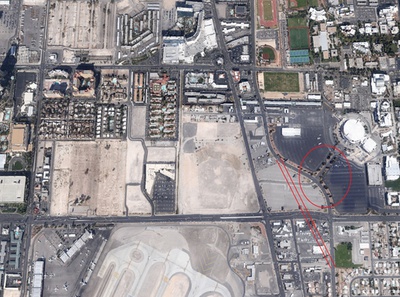Thursday, June 12, 2014 | 2 a.m.
UNLV has scrapped its proposed location for its new on-campus football stadium because of concerns about its proximity to McCarran International Airport.
The university is now looking for a new site for its 50,000-seat stadium. Alternative stadium locations include the parking lot of the Thomas & Mack Center and 40 acres of privately owned land at the corner of Koval Lane and Tropicana Avenue.
Since UNLV announced plans to build a stadium in 2011, Federal Aviation Administration officials have raised concerns about the facility’s height and proximity to the airport.
UNLV officials had planned to build the stadium on 60 acres of university-owned land northeast of Swenson Street and Harmon Avenue. The site was less than two miles from Las Vegas’ major airport, and was in the direct path of flights coming in and out of the city.
The FAA argued the UNLV stadium could affect planes’ departure and landing routes, block radar and interfere with communication signals between aircraft and the air-control tower.
Initially, UNLV officials believed they could design and construct a stadium within the FAA’s building parameters.
Officials had contemplated sinking the stadium into the ground to maintain a height of about 110 feet, which is similar to UNLV’s Thomas & Mack Center nearby. They also considered lobbying the FAA for special approvals that would allow the university to build a stadium up to 180 feet high.
However, after consulting with outside professionals, UNLV officials have decided that the current location for the stadium is no good.
“After looking at this every which way, we have determined this is just not a feasible site,” said Gerry Bomotti, UNLV’s senior vice president for finance and business.
For the past several months, UNLV officials have been speaking with a group of FAA, airport, airline and pilot representatives to hear out their concerns. The university also hired consultant Capitol Airspace for about $30,000 to study the matter.
Even if UNLV could build a stadium at the site with FAA approval, transportation officials and consultants feared it would have a “negative impact” on the airport. The FAA could approve the UNLV stadium location, but then turn around and tell airport officials to make flight changes and safety accommodations for the new building, which could have a “significant economic impact” to one of the region’s major transportation lifelines.
“It would have caused a massive headache for the airlines having to deal with this,” Bomotti said. “As we got into it, it became clear that ‘Gee, it’s just not feasible.’ It never was our intention to create a stadium with a positive economic impact to the region at the detriment to its major airport.”
UNLV is now looking at several alternative locations for the stadium, both on campus and off. The new stadium location will require a revision to UNLV’s campus master plan.
The university has hired an engineering consultant Kimley Horn for about $15,000 to study possible new sites. Both Capitol Airspace and Kimley Horn, as well as stadium consultant CSL International, are being paid from the legislatively approved 2 percent allotment of slot tax reimbursements, which is expected to total $950,000.
One alternative location being discussed is located southwest of the Thomas & Mack Center. The site currently serves as the basketball arena’s parking lot. To make this location work, UNLV officials must seek approvals from Clark County, the U.S. Postal Service and other landowners to move Swenson Street to the southwest. This “realignment,” Bomotti said, would help accommodate the new stadium.
The second alternative location served as “Plan B” for Majestic Realty, UNLV’s former developer partner. When the university announced its intention to sever ties with the Los Angeles developer last year, its billionaire president and board chairman Ed Roski announced a new plan to build a UNLV stadium on 42 acres of land — owned by Wells Fargo Bank — at the corner of Koval Lane and Tropicana Avenue. Majestic scrapped that plan after being rebuffed for the second time by UNLV.
The current iteration of UNLV’s stadium project is expected to cost $490 million to $714 million, depending on whether it's open-air or covered. It is expected to generate $7 million to $12.1 million in profit during its first year, again depending on the stadium type.
These cost calculations for the stadium construction and amenities don’t include cost for site and traffic improvements. New parking garages are expected to cost about $160 million. Traffic improvements, excluding a possible Swenson Street “realignment,” could cost about $15 million.
UNLV officials plan to update the Campus Improvement Authority Board next week about this new development. The stadium authority is tasked with coming up with UNLV stadium recommendations for state lawmakers by Oct. 1. )
The stadium authority is charged with seeking public input on the potential need for a stadium, re-envisioning UNLV’s stadium plan and determining its feasibility. The board’s jurisdiction extends only to UNLV’s Maryland Parkway campus borders, which would preclude its gaming and university members from discussing Majestic’s “Plan B” location.
Bomotti on Wednesday said he doesn't see the site change as having “a material impact" on (the board’s) schedule.
“We always knew the stadium was close to the airport. We always knew we had to vet it,” Bomotti said. “We have other options. We’ll find another site.”



Join the Discussion:
Check this out for a full explanation of our conversion to the LiveFyre commenting system and instructions on how to sign up for an account.
Full comments policy